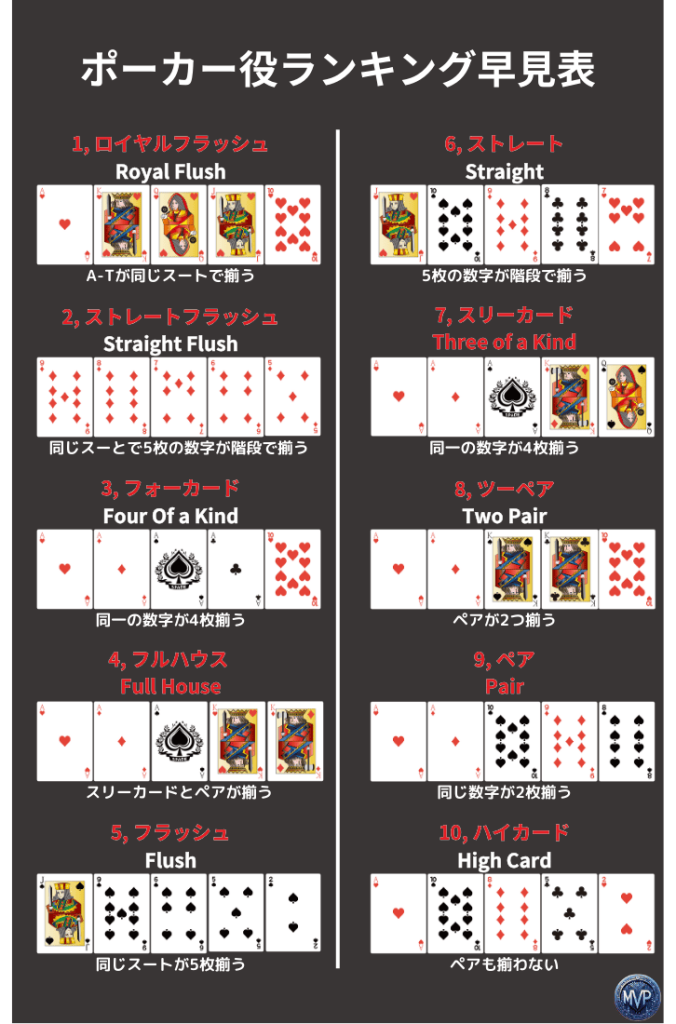Poker is not just a game of luck; it requires knowledge, skill, and psychological tactics. Among the many poker hands, a “Full House” is one of the most powerful, capable of significantly altering the course of a game. This guide will provide a comprehensive explanation of Full House, including its definition, odds, strategy, key considerations, and even its historical background and trivia. Whether you are a beginner or an advanced player, this article will offer valuable insights. Let’s dive in!
What is a Full House?

A Full House is a poker hand consisting of three cards of the same rank (Three of a Kind) and a pair of another rank. For example:
- K-K-K-J-J (Three Kings + a Pair of Jacks)
- 8-8-8-2-2 (Three Eights + a Pair of Twos)
This hand ranks high in poker, being stronger than a Flush and a Straight but weaker than a Four of a Kind or a Straight Flush.
Strength of a Full House

When comparing hands, the strength of a Full House is determined primarily by the Three of a Kind. For example:
- A♦ A♠ A♣ 9♥ 9♠ is stronger than 7♦ 7♠ 7♣ 9♥ 9♠
- The higher the Three of a Kind, the stronger the Full House
Examples:
- Strong Full House: A-A-A-K-K
- Weaker Full House: 5-5-5-4-4
Probability of Getting a Full House
The probability of forming a Full House depends on the stage of the game and the number of players. Here are some approximate odds:
| Stage | Probability | Notes |
| Pre-flop | 0.1441% | Roughly 1 in 7,000 hands |
| After the Flop | ~2% | Higher if the board has a pair or trips |
| After the Turn | ~9% | If you already have Three of a Kind, the Turn may complete the hand |
Example Scenario:
If you hold 10-10, and the Flop is 10-5-5, a 5 or 10 on the Turn or River will give you a Full House.
When to Aim for a Full House
A Full House is a powerful hand, but choosing the right moments to pursue it is crucial. Here are some ideal situations:
1. When You Have Trips on the Flop
If you hit Three of a Kind on the Flop, the chances of forming a Full House increase. Carefully observe opponents’ actions and play accordingly.
2. When the Board Shows a Pair
If the community cards contain a pair, a Full House may be within reach, especially if you have a pocket pair.
Example: If the Flop is Q-Q-7, and you hold 7-7, you now have a Full House (Sevens over Queens).
3. Watching Opponents’ Betting Patterns
If an opponent is betting aggressively, they may already have a Full House or an even stronger hand. Analyzing their moves can prevent costly mistakes.
Key Considerations When Playing a Full House
1. Beware of Higher Full Houses
If two players have Full Houses, the one with the higher Three of a Kind wins. For example:
- A-A-A-2-2 defeats K-K-K-Q-Q
2. Recognizing Bluffs
When the board makes a Full House possible, some players may bluff. Always analyze the situation carefully before making big bets.
3. Caution with Overbets
A large bet from an opponent could indicate an even stronger hand like Four of a Kind or a Straight Flush. Be aware of the board texture and bet accordingly.
History and Trivia of Full House
1. The Role of Full House in Western Movies
In classic Western films, the Full House has often played a crucial role in high-stakes poker games, with A-A-A-K-K being a legendary winning hand.
2. Full House in Professional Poker
Many famous poker tournaments have seen dramatic victories with Full Houses, demonstrating their power in high-stakes play.
3. Fun Facts
- Some believe the term “Full House” originates from the idea of “completing a house” with three and two matching cards.
- A famous scene in the movie Las Vegas Groove features a dramatic game-changing Full House.
Mindset When Playing a Full House
1. Understand Expected Value (EV)
Since Full Houses are rare, it is essential to play them only when the risk-to-reward ratio is favorable.
2. Observe Opponents’ Behavior
Reading an opponent’s reactions is key. Some may slow-play their hands, while others might overbet with weaker holdings.
3. Avoid Unnecessary Risks
If you are already ahead, there is no need to take excessive risks. Play smart and secure the pot without overcommitting.
How to Practice Full House Strategies
1. Hand Selection Training
Learn to identify strong starting hands that can evolve into Full Houses. Pay attention to pairs and suited connectors.
2. Pot Analysis
Monitor pot sizes and betting patterns to make informed decisions about when to commit chips with a Full House.
3. Online Poker Simulations
Using online poker platforms can help you practice Full House situations in real-time. Try Meta Vault Poker (MVP) for free tournaments and crypto-based gameplay.

Differences Between Live and Online Poker When Playing a Full House
| Factor | Live Poker | Online Poker |
| Reading Opponents | Physical tells like facial expressions | Observing bet patterns |
| Game Speed | Slower-paced | Fast-paced |
| Player Pool | Limited by location | Global players, more hands played |
| Bonuses | Fewer promotions | Frequent bonuses & tournaments |
| Risk of Cheating | Physical security measures | Possibility of bots and collusion |
Beginner Tips for Mastering Full House Play
- Choose Strong Starting Hands – Pocket pairs are the best candidates for Full Houses.
- Manage Your Bankroll – Don’t overcommit chips on a weak Full House.
- Study Opponents – Adjust your strategy based on their playing style.
- Practice Regularly – Online poker is a great way to gain experience.
- Know When to Fold – If the board suggests a stronger hand is possible, play cautiously.
Conclusion
A Full House is one of the most valuable hands in poker, offering players significant winning potential. However, knowing when to play aggressively and when to be cautious is key. By understanding its probabilities, strategic applications, and historical significance, you can maximize your success. Whether playing live or online, use these insights to refine your skills and dominate the poker table.


